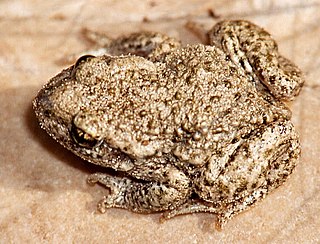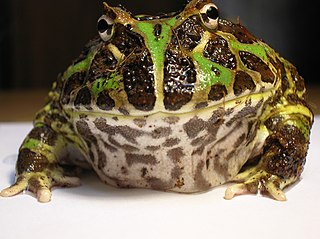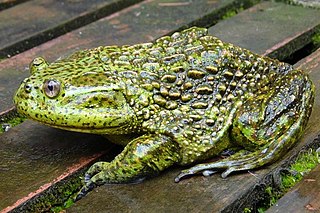
The Alytidae are a family of primitive frogs. Their common name is painted frogs or midwife toads. Most are endemic to Europe, but three species occur in northwest Africa, and a species formerly thought to be extinct is found in Israel.

The Pipidae are a family of primitive, tongueless frogs. The 41 species in the family Pipidae are found in tropical South America and sub-Saharan Africa.

The Ceratophryidae, also known as common horned frogs, are a family of frogs found in South America. It is a relatively small family with three extant genera and 12 species. Despite the common name, not all species in the family have the horn-like projections at the eyes. They have a relatively large head with big mouth, and they are ambush predators able to consume large prey, including lizards, other frogs, and small mammals. They inhabit arid areas and are seasonal breeders, depositing many small eggs in aquatic habitats. Tadpoles are free-living and carnivorous or grazers (Chacophrys).
Elachistocleis skotogaster is a species of frog in the family Microhylidae. It is known with certainty only from the Salta Province in northern Argentina. However, the type locality and some later observations are near the border to Bolivia, and it is possible that some frogs from Bolivia currently attributed to Elachistocleis ovalis belong to this species.
Saltenia is an extinct genus of frogs. It was assigned to the family Pipidae by R. L. Carroll in 1988 and again in 2005 by A. M. Báez and T. Harrison. The single described species, Saltenia ibanezi, is thought to have lived in South America in the Late Cretaceous.
Avitabatrachus uliana is the only species discovered so far in the extinct genus Avitabatrachus, a genus of prehistoric frogs that lived in the Middle Cretaceous. Fossils of A. uliana were found in the Candeleros Formation of northwestern Patagonia in Argentina. It was properly described in 2000 and was then concluded to be most closely related to Pipidae frogs. Hence, it was included in Pipimorpha.
Baurubatrachus is an extinct genus of prehistoric frogs found in the Maastrichtian Marília Formation of Brazil, formerly considered to be related to the extant family Ceratophryidae. However, a detailed assessment of the anatomy and relationships of the single known fossil of Baurubatrachus demonstrated that it is not part of Ceratophryidae and might be part of a much ancient group of Neobatrachia.
Nevobatrachus gracilis is the only species in the extinct genus Nevobatrachus, a genus of prehistoric frogs. The original generic name of this frog was Cordicephalus Nevo (1968); however, this generic name turned out to be preoccupied by a cestode genus Cordicephalus Wardle, McLeod & Stewart (1947), which remains nomenclaturally available in spite of being considered a junior synonym of the diphyllobothriid genus Pyramicocephalus. Mahony (2019) coined a replacement name Nevobatrachus. Fossils of N. gracilis were found in a lacustrine deposit in Makhtesh Ramon called "Amphibian Hill" and it is believed they lived during the Lower Cretaceous.
Erythrobatrachus is an extinct genus of trematosaurian temnospondyl within the family Trematosauridae. The sole species Erythrobatrachus noonkanbahensis was separated to a monotypic genus, distinguishing it from related taxa when the description was published in 1972. The type material was a matrix cast revealing the impression of several fragments of skull excavated at the Blina Shale formation in the northwest of the Australian continent. The genus name is derived from ancient Greek, combining terms for red, erythro, with frog, batrachos, to describe the iron staining of the fossilised amphibian specimens. The type location described by the specific epithet was Noonkanbah Station.

Eodiscoglossus is an extinct genus of prehistoric frogs. It is known from the type species E. santonjae from the Early Cretaceous (Barremian) El Castellar Formation of Spain, as well as a referred species E. oxoniensis known from the Forest Marble Formation of the UK. It was a small primitive frog, with a length of only 27 mm (1.1 in) from the premaxilla to the ischium. Formerly considered to be closely related to discoglossids, E. santonjae is now regarded as close to the root of the crown group of modern frogs in a position more derived than New Zealand frogs and tailed frogs, but more basal than costatans like alytids and other more advanced frogs like neobatrachians. The morphology of E. santonjae suggests a generalist and unspecialised movement habit. The referral of E. oxoniensis to Eodiscoglossus has been questioned, as it is much earlier than the type species and it is based on homoplasic and plesiomorphic characteristics inherited from a common ancestor, so there is no clear evidence of a close relation.
Wealdenbatrachus is an extinct genus of prehistoric frog known from the Lower Cretaceous of Uña, Spain, which is part of the La Huérguina Formation Its anatomy and relationships have recently been revisited, finding that this frog might be a proficient jumper, and that it was a primitive frog close to the ancestry of all modern frogs.
Pachycentrata is an extinct genus of prehistoric amphibian.
Shelania is an extinct genus of prehistoric frogs that lived in South America during the Eocene. Its type species is Shelania pascuali. Fossils of Shelania have been found in the Mustersan Vaca Mahuida and Laguna del Hunco Formations of Argentina.

Trimerorhachis is an extinct genus of dvinosaurian temnospondyl within the family Trimerorhachidae. It is known from the Early Permian of the southwestern United States, with most fossil specimens having been found in the Texas Red Beds. The type species of Trimerorhachis, T. insignis, was named by American paleontologist Edward Drinker Cope in 1878. Cope named a second species from Texas, T. mesops, in 1896. The species T. rogersi and T. greggi are also from Texas, and the species T. sandovalensis is from New Mexico.

Singidella is an extinct genus of prehistoric frog from the Eocene of Tanzania. It is a member of the family Pipidae, and is closely related to African dwarf frogs (Hymenochirus) and Merlin's dwarf gray frog (Pseudohymenochirus).

Calyptocephalella is a genus of frogs in the family Calyptocephalellidae. It is represented by a single living species, Calyptocephalella gayi, commonly known as the helmeted water toad, Chilean helmeted bull frog or wide-mouth toad. Additionally, there are a few extinct species that only are known from Late Cretaceous and Paleogene fossil remains from Patagonia in South America and in the Antarctic Peninsula. The helmeted water toad living today is aquatic to semi-aquatic, and found in deep ponds and reservoirs in central Chile and possibly adjacent west-central Argentina.
Enneabatrachus is an extinct genus of prehistoric frogs known from the late Jurassic Morrison Formation. It is represented by a single species, E. hechti, whose remains have been recovered from stratigraphic zone 5. One specimen has been recovered from Quarry 9 of Como Bluff in Wyoming and another specimen was later reported from Dinosaur National Monument. A small discoglossid frog whose name means "nine frog" after the quarry in which it was discovered. The Como Bluff specimen was an ilium only a few millimeters long. E. hechti's live weight would have only been a few grams.
Thoraciliacus rostriceps is an extinct species of frog from the Cretaceous period and the only species of the genus Thoraciliacus, which is classified in the unranked clade Pipimorpha. Fossils of T. rostriceps were found in Makhtesh Ramon, Negev Desert, Israel and it is believed they lived during the Barremian. Other fossils have been found near Marydale, South Africa in an Upper Cretaceous lake.

Pipimorpha is an unranked clade containing all frogs which are more closely related to living Pipidae species than to living Rhinophrynus species. Members of this group are highly adapted to aquatic life. The oldest pipimorphs are Neusibatrachus and Gracilibatrachus from the Early Cretaceous of Spain, with other records of the group known from Afro-Arabia and South America like modern Pipidae. The extinct family Palaeobatrachidae, particularly the genus Palaeobatrachus were widespread and abundant in Europe during the Cenozoic, until their extinction during the Middle Pleistocene around 500,000 years ago due to being unable to cope with the increasing aridity and freezing temperatures of the ice ages.
The Huitrera Formation is a geological formation in the Neuquén Basin in northern Patagonian Argentina whose strata date back to the Early Eocene of the Paleogene, or Casamayoran in the South American land mammal age classification.







